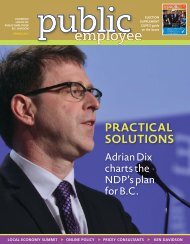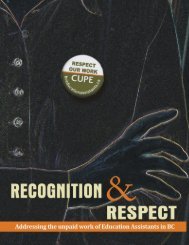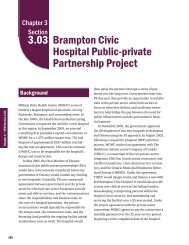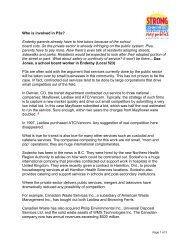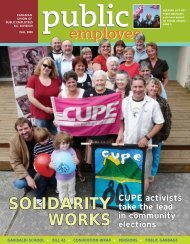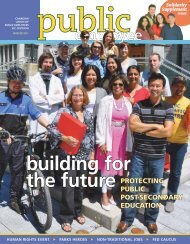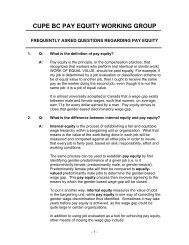Roles and Responsibilities of Teachers and Teacher Assistants ...
Roles and Responsibilities of Teachers and Teacher Assistants ...
Roles and Responsibilities of Teachers and Teacher Assistants ...
You also want an ePaper? Increase the reach of your titles
YUMPU automatically turns print PDFs into web optimized ePapers that Google loves.
<strong>Roles</strong> <strong>and</strong><strong>Responsibilities</strong><strong>of</strong> <strong><strong>Teacher</strong>s</strong> <strong>and</strong><strong>Teacher</strong> <strong>Assistants</strong>/Education <strong>Assistants</strong>A BCTF/CUPE Joint Paper
Table <strong>of</strong> ContentsPresident’s Message . . . . . . . . . . . . . . . . . . . . . . . . . . . 1A Brief History . . . . . . . . . . . . . . . . . . . . . . . . . . . . . 2Context . . . . . . . . . . . . . . . . . . . . . . . . . . . . . . . . 3Special Education Policy, Procedures, <strong>and</strong> Guidelines 4Collective Agreements . . . . . . . . . . . . . . . . . . . . . . . . . . 4The Role <strong>of</strong> the Ministry <strong>of</strong> Education <strong>and</strong> School Districts 4<strong><strong>Teacher</strong>s</strong>’ <strong>and</strong> <strong>Teacher</strong> <strong>Assistants</strong>’ Working Relationship: General <strong>Responsibilities</strong> . . . . 5Glossary 5Specific <strong>Responsibilities</strong> 6• Designing programs . . . . . . . . . . . . . . . . . . . . . . . . 6• Implementing programs 7• Assessing, evaluating, reporting . . . . . . . . . . . . . . . . . . . . 8• Developing supportive environments . . . . . . . . . . . . . . . . . 9
British Columbia<strong><strong>Teacher</strong>s</strong>’ FederationDecember 2009Message from the Presidents <strong>of</strong> BCTF <strong>and</strong> CUPE BCDear Colleagues <strong>and</strong> Education Partners:We are very pleased <strong>and</strong> proud to introduce to you this joint position paper entitled <strong>Roles</strong><strong>and</strong> <strong>Responsibilities</strong> <strong>of</strong> <strong><strong>Teacher</strong>s</strong> <strong>and</strong> <strong>Teacher</strong> <strong>Assistants</strong>/Education <strong>Assistants</strong>.It is the result <strong>of</strong> much effort <strong>and</strong> determination over many years by a number <strong>of</strong> individualsserving on the joint committee, as well as groups such as the CUPE BC K-12 Committee, theCUPE BC Special Education Task Force, <strong>and</strong> the BCTF Special Education Association. Thispaper represents our ability to work together to reach consensus <strong>and</strong> to move forward tostrengthen <strong>and</strong> enhance public education for all children in British Columbia.It articulates our basic assumption that the roles <strong>of</strong> both teachers <strong>and</strong> teacher assistants areintegral to ensuring the success <strong>of</strong> students with special needs. Further it makes clear thatBCTF <strong>and</strong> CUPE BC have a fundamental role to play in supporting the development <strong>of</strong> goodworking relationships at the school level. This paper should assist collegial teams at the locallevel to continue to develop working relationships <strong>and</strong> to address conflicts that may arise.The primary focus <strong>of</strong> this paper is the roles <strong>and</strong> responsibilities <strong>of</strong> those who work mostclosely with students—teachers <strong>and</strong> teacher assistants. However, the critical role <strong>of</strong> theMinistry <strong>of</strong> Education <strong>and</strong> school districts in establishing the necessary conditions forstudents with special needs to have successful, positive, <strong>and</strong> productive learning experiencesin the public schools <strong>of</strong> British Columbia cannot be over-emphasized.On behalf <strong>of</strong> BCTF <strong>and</strong> CUPE BC, we thank the joint committee members for theircommitment <strong>and</strong> effort. We look forward to dialogue with our members <strong>and</strong> with alleducation partners on the important issue <strong>of</strong> quality public education for students withspecial needs.____________________________________________Irene LanzingerPresident, BC <strong><strong>Teacher</strong>s</strong>’ Federation_____________________________________________Barry O’NeillPresident, Canadian Union <strong>of</strong>Public Employees BC1
A brief historyIn the Spring <strong>of</strong> 1995, BCTF <strong>and</strong> CUPE BC convened a small joint committee to address specialeducation issues pertaining to:<strong>Roles</strong> <strong>and</strong> responsibilities <strong>of</strong> teachers <strong>and</strong> teacher assistants;Training programs for teacher assistants;Projects to assist members in dealing with classroom issues.The joint committee met for the first time June 5, 1995. Much work was done by this <strong>and</strong>subsequent joint committees, including plans for a brochure, research projects, <strong>and</strong> problemsolvingapproaches to dealing with contentious issues, as well as identification <strong>of</strong> issues <strong>of</strong>mutual interest <strong>and</strong> concern.However, the statement <strong>of</strong> roles <strong>and</strong> responsibilities remained unfinished.In the fall <strong>of</strong> 1999, CUPE BC <strong>and</strong> BCTF again recognized the commonality <strong>of</strong> issues <strong>and</strong>concerns relating to special education, <strong>and</strong> the imperative provided by the provincialreview <strong>of</strong> special education. It was agreed to reconstitute a joint committee, with the aim <strong>of</strong>reaching agreement on the roles <strong>and</strong> responsibilities <strong>of</strong> teachers <strong>and</strong> teacher assistants forrecommendation to government.In May 2000, BCTF <strong>and</strong> CUPE BC resumed meetings, <strong>and</strong> the <strong>Roles</strong> <strong>and</strong> <strong>Responsibilities</strong> <strong>of</strong><strong><strong>Teacher</strong>s</strong> <strong>and</strong> <strong>Teacher</strong> <strong>Assistants</strong> position paper was endorsed by both union executives inApril 2001.In December 2008, BCTF <strong>and</strong> CUPE BC began discussions with a view to updating thedocument. The updated document was endorsed by both union executives in 2009.Members <strong>of</strong> the most recent joint committee:CUPE BC:BCTF:Susan Blair, June Kaiser, Dee Beattie, Paul Tetrault, John MalcolmsonJim Iker, Jinny Sims, Janice Neden, Leann Buteau, Charlie Naylor, David Halme2
<strong>Roles</strong> <strong>and</strong> <strong>Responsibilities</strong> <strong>of</strong> <strong><strong>Teacher</strong>s</strong> <strong>and</strong> <strong>Teacher</strong><strong>Assistants</strong> / Education <strong>Assistants</strong>: A BCTF/CUPE joint paperContextBCTF <strong>and</strong> CUPE BC recognize that teachers <strong>and</strong> teacher assistants play a key role in programsfor students with special needs. This paper is intended to assist teachers <strong>and</strong> teacherassistants in establishing a co-operative, respectful working relationship to ensure thesuccess <strong>of</strong> students with special needs.<strong>Teacher</strong> assistants work under the general direction <strong>of</strong> a teacher in the school, <strong>and</strong> under thesupervision <strong>of</strong> the principal/vice-principal. Overall, the relationship between teachers <strong>and</strong>teacher assistants has seen the development <strong>of</strong> a more collegial model.“<strong>Teacher</strong>” in this document refers to all teachers, including classroom teachers, specialeducation support teachers, learning assistance teachers, <strong>and</strong> other non-enrolling teachers.“<strong>Teacher</strong> Assistant” in this document refers to all teacher assistants <strong>and</strong> parapr<strong>of</strong>essionalswho are working with teachers to support students with special needs.This joint statement elaborates the roles <strong>and</strong> responsibilities <strong>of</strong> teachers <strong>and</strong> teacherassistants as defined initially by, <strong>and</strong> within, the confines <strong>of</strong> the British Columbia School Act<strong>and</strong> Regulations, Ministry <strong>of</strong> Education Special Education Policy, Procedures <strong>and</strong> Guidelines,<strong>and</strong> collective agreements <strong>of</strong> both BCTF, its locals, <strong>and</strong> CUPE BC with the employing schooldistrict/BCPSEA.<strong>Teacher</strong> assistants are supervised in regard to the employment relationship (e.g., evaluationreports, discipline) by the principal/vice-principal, not the teacher with whom the teacherassistants work.1. Boards may employ persons other than teachers to assist teachers in carrying outtheir responsibilities <strong>and</strong> duties under this Act <strong>and</strong> in the Regulations.2. Persons employed under subsection (1) shall work under the general supervision <strong>of</strong>a teacher or principal/vice-principal.Section 18 (www.bced.gov.bc.ca/legislation/schoollaw/revisedstatutescontents.pdf) <strong>of</strong> theSchool Act: (04 06 09)The index to the School Act <strong>and</strong> related legislation uses the term <strong>Teacher</strong> Assistant to identify the parapr<strong>of</strong>essional role. There are, however,numerous other titles in use within the province. CUPE BC is actively seeking changes to Section 18 <strong>of</strong> the current School Act in order tost<strong>and</strong>ardize job titles to Education Assistant <strong>and</strong> to reflect current employment relationships as reflected in CUPE BC collective agreements.3
1. Special Education policy, procedures, <strong>and</strong> guidelinesThe following excerpts are taken from the Ministry <strong>of</strong> Education Manual <strong>of</strong> Policies,Procedures, <strong>and</strong> Guidelines for Special Education Services (Section B.3):“The teacher responsible for a student with special needs is responsible for designing,supervising, <strong>and</strong> assessing the educational program for that student.”“<strong><strong>Teacher</strong>s</strong> are expected to design programs for students with special needs. <strong><strong>Teacher</strong>s</strong>’assistants play a key role in many programs for students with special needs, performingfunctions which range from personal care to assisting the teacher with instructionalprograms. Under the direction <strong>of</strong> a teacher they may play a key role in implementing theprogram.”“While teacher assistants may assist in the collection <strong>of</strong> data for the purpose <strong>of</strong> evaluatingstudent progress, the teachers are responsible for evaluating <strong>and</strong> reporting on theprogress <strong>of</strong> the student to parents.”2. Collective agreements<strong><strong>Teacher</strong>s</strong> <strong>and</strong> teacher assistants are covered by collective agreements between theunions that represent them <strong>and</strong> the employer. Many <strong>of</strong> these agreements have provisionsthat set out some conditions relevant to roles <strong>and</strong> responsibilities. Collective agreementsmust be followed <strong>and</strong> take precedence.3. The role <strong>of</strong> the Ministry <strong>of</strong> Education <strong>and</strong> school districts inensuring conditions for success <strong>of</strong> students with special needs<strong><strong>Teacher</strong>s</strong> <strong>and</strong> teacher assistants agree that the responsibility <strong>of</strong> the Ministry <strong>of</strong> Education<strong>and</strong> the school district is paramount in ensuring the necessary conditions for studentswith special needs to succeed in schools. These conditions include but are not limited to:3.1 Provision <strong>of</strong> adequate resources to maintain an appropriate learning environment.3.2 Availability <strong>of</strong> a suitable workspace to accommodate the learning activities <strong>of</strong> thoseworking with students with special needs.3.3 Access to appropriate information regarding the student, the Individual EducationPlan (IEP), as well as techniques <strong>and</strong> strategies necessary to carry out the respectiveresponsibilities <strong>of</strong> each in relation to students’ programs.3.4 Provision <strong>of</strong> appropriate in-service on instructional <strong>and</strong> behavioural techniques <strong>and</strong>strategies.3.5 Adequate release time for members <strong>of</strong> the school-based team, <strong>and</strong> adequate timewithin the school day for members <strong>of</strong> the student-specific support team, includingthe teacher <strong>and</strong> the teacher assistants, to participate as required in the process <strong>of</strong>developing, implementing, <strong>and</strong> monitoring the IEP.4
4. <strong><strong>Teacher</strong>s</strong>’ <strong>and</strong> teacher assistants’working relationship: General responsibilitiesInherent in the School Act <strong>and</strong> Special Education Policy, Procedures <strong>and</strong> Guidelines isthe teacher’s responsibility for designing, implementing, <strong>and</strong> evaluating the educationalprogram, <strong>and</strong> the teacher assistant’s role to assist teachers in this responsibility. Both theteacher <strong>and</strong> the teacher assistant facilitate the inclusion <strong>of</strong> students with special needs.It is their joint role to encourage the student to become an independent learner <strong>and</strong>member <strong>of</strong> the classroom, school, <strong>and</strong> community.In order to foster a co-operative, respectful working relationship, teacher assistants needto be aware <strong>of</strong> those responsibilities that are specific to teachers.Similarly, teachers need to be aware <strong>of</strong> job descriptions <strong>and</strong> the parameters <strong>of</strong> theresponsibilities <strong>of</strong> teacher assistants.To provide effective support for students with special needs, teachers <strong>and</strong> teacherassistants work together <strong>and</strong> share responsibility to:4.1 Develop a positive, respectful working relationship.4.2 Meet st<strong>and</strong>ards <strong>of</strong> pr<strong>of</strong>essional <strong>and</strong> ethical conduct in relation to students, parents,<strong>and</strong> colleagues.4.3 Advocate for conditions <strong>of</strong> success for students with special needs.4.4 Advocate for the protection <strong>of</strong> the legal <strong>and</strong> human rights <strong>of</strong> students <strong>and</strong> their families.4.5 Follow guidelines established by the school/district to protect the safety <strong>and</strong> wellbeing <strong>of</strong> children <strong>and</strong> youth.4.6 Maintain positive, supportive, pr<strong>of</strong>essional relationships within the education community.5. GlossaryIEP ( Individual Education Plan): a written plan, developed for a student, which describesthe program modifications <strong>and</strong>/or significant adaptations for the student <strong>and</strong> the servicesthat are to be provided.Adaptation: retains the learning outcomes <strong>of</strong> the prescribed curriculum but includes changessuch as alternate formats (e.g. Braille, use <strong>of</strong> technology), instructional strategies (e.g. use <strong>of</strong>interpreter, visual cues), <strong>and</strong> assessment procedures (e.g. oral exams, additional time).Modification: changes to learning outcomes which are substantially different from theprescribed curriculum, <strong>and</strong> specifically selected to meet the student’s special needs.http://bctf.ca/issues/resources.aspx?id=105725
6. Specific responsibilitiesThe following are some specifics <strong>of</strong> the roles <strong>and</strong> responsibilities <strong>of</strong> teachers <strong>and</strong> teacherassistants, <strong>and</strong> some roles <strong>and</strong> responsibilities that they share.6.1 Designing programs <strong>and</strong> planning <strong>and</strong> organizinglearning experiences for students with special needsTEACHER SHARED TEACHER ASSISTANT• Designs instructionalprogram.• Develops IEPs.• Identifies responsibilities<strong>of</strong> individual members<strong>of</strong> student specificsupport teams interms <strong>of</strong> participatingin the development,implementation, <strong>and</strong>monitoring <strong>of</strong> the programsas described in the IEP.• Plans learning activities.• Determines appropriatemodifications <strong>and</strong>adaptations in line with IEPgoals.• Identifies the appropriateinstructional learningresources.• When needed, advocates forthe appropriate instructionallearning resources.• Reviews <strong>and</strong> reinforceslearning activities for concept<strong>and</strong> skill development.• Discuss learners’ strengths<strong>and</strong> weaknesses <strong>and</strong> considerbest possible areas <strong>of</strong>program focus.• Attend program planningmeetings, based on school<strong>and</strong> district policies, to assistwith developing IEPs <strong>and</strong>transition plans for children<strong>and</strong> youth with special needs.• Discuss objectives <strong>and</strong> goals.• Discuss <strong>and</strong> clarify, on aregular basis, the ways inwhich the teacher assistantscan assist the teacher withinstructional programs,classroom management,<strong>and</strong> expectation setting forstudents.• Discuss adaptations <strong>and</strong>modifications to curriculum<strong>and</strong> resource materials.• Discuss what instructionallearning resources areneeded to reach IEP goals(e.g. flash cards, social stories,abacus, etc.).• Review learning resourcestogether to clarify <strong>and</strong>share experiences <strong>and</strong>expectations.• Shares relevant informationabout the performance<strong>and</strong> behaviour <strong>of</strong> individuallearners to support IEP goals,transition, <strong>and</strong> programdesign.• Gathers relevant informationthrough working withstudent or students toprovide feedback into theplanning process.• Produces materials <strong>and</strong>implements strategies toaccommodate individuallearner needs/styles.• Assists with development<strong>of</strong> instructional learningresources.• Reviews <strong>and</strong> reinforceslearning activities usinglesson plans <strong>and</strong> learningstrategies developed bythe teacher/team to helpstudents master concepts<strong>and</strong> skills.6
TEACHER SHARED TEACHER ASSISTANT• Develops school-basedlearning goals for individuals<strong>and</strong> groups.• Plan activities to meet goals. • Assists students with learningactivities <strong>and</strong>/or independentstudy projects developed byteacher/team.• Monitors <strong>and</strong> reportsto teacher/team onimplementation <strong>of</strong> theprogram.• Designs learning <strong>and</strong>skill development goalsfor worksites <strong>and</strong> othercommunity-based settings.• Establishes work planpriorities.• Provides the teacherassistant with the requisiteinformation regarding theclassroom managementstructure, discipline plan, <strong>and</strong>expectations for students.• Plan activities to meet goals.• Share resources <strong>and</strong>concerns.• Review plan daily <strong>and</strong> weekly• Set consultative meetingtimes.• Discuss <strong>and</strong> clarify classroommanagement structure,discipline plan, <strong>and</strong>expectations for students.• Supports learning <strong>and</strong> skilldevelopment activities inworksite <strong>and</strong> communitybasedsettings.• Follows priority plan.• Keeps teacher up to date onthe implementation <strong>of</strong> theprogram.• Carries out work withindeveloped structures <strong>and</strong>plans, being consistent withexpectations for students.6.2 Implementing programs for studentswith special needs: Delivery <strong>of</strong> serviceTEACHER SHARED TEACHER ASSISTANT• Instructs, supervises, <strong>and</strong>facilitates student learning.• Develops individualized,appropriate, behaviouralprogram.• Defines the use <strong>of</strong> specifictechniques, strategies,<strong>and</strong> appropriate language,as required in individualsituations.• Seeks assistance <strong>of</strong> principalto provide a workplace forthe teacher assistant.• Discuss successful practicewith goals in mind (e.g. IEP,behaviour plan, safety plan,etc.).• Discuss specific philosophy,techniques, strategies, <strong>and</strong>appropriate language.• Discuss specific techniques,strategies, <strong>and</strong> appropriatelanguage.• Discuss <strong>and</strong> identifyworkplace settings.• Facilitates student learningindividually <strong>and</strong> in smallgroups.• Implements the techniques<strong>and</strong> strategies as discussed.• Documents, monitors, <strong>and</strong>reports to teacher/teamon implementation <strong>of</strong> theprogram.• Implements specifictechniques, strategies,<strong>and</strong> appropriate languageas discussed <strong>and</strong>/ordemonstrated.• Monitors effectiveness <strong>of</strong>workplace settings <strong>and</strong> reportsto teacher <strong>and</strong>/or principal.7
6.3 Assessing, evaluating, reporting <strong>and</strong> recording student progressTEACHER SHARED TEACHER ASSISTANT• Ensures assessment <strong>and</strong>learner pr<strong>of</strong>iles are current.• Convenes/attends meetings<strong>of</strong> student specific supportteam within a teacher’sinstructional hours <strong>and</strong> TA’spaid work hours.• Evaluates progress accordingto goals <strong>of</strong> IEP.• Reports to parents(a) informal, ongoing, <strong>and</strong>(b) formal, written reports.• Maintains required school,school district, <strong>and</strong> provincialrecords.• Discuss information.• Discuss information with theentire team.• Exchange <strong>and</strong> discussinformation.• Discuss relevant confidentialinformation.• Clarify data requirements.• Carries out functional(informal) assessmentactivities to assist the teacherin developing learner pr<strong>of</strong>iles.• Attends meetings <strong>of</strong> studentspecific support team duringpaid work hours.• Observes <strong>and</strong> documentslearner strengths,achievements, <strong>and</strong> needsthrough daily learningactivities.• Assists in the collection<strong>of</strong> data for the purpose <strong>of</strong>evaluating student progress.• Provides informationto teacher for home/school formal/informalcommunications.• Assists in maintaining learnerrecords required by school,school district, or provincialpolicy.8
6.4 Developing supportive environments:For learners, their families, school <strong>and</strong> district staffsTEACHER SHARED TEACHER ASSISTANT• Documents <strong>and</strong> sharesworkplace concerns.• Remains current in school,district, <strong>and</strong> provincialpolicies <strong>and</strong> procedures.• Reviews <strong>and</strong> monitorsthat policies are beingimplemented.• Shares information.• Shares relevant studentrelatedinformation onbehaviour, social, emotional,<strong>and</strong> physical health subject toprivacy regulations• Requests that appropriatehealth or other training isprovided to support staff.• Discuss concerns to facilitateearly problem solvingthrough informal <strong>and</strong>regularly scheduled meetingsduring the workday.• Follow guidelines establishedby the school/district toprotect the safety <strong>and</strong> wellbeing<strong>of</strong> children, youth, <strong>and</strong>staff.• Maintain confidentiality.• Support occupational <strong>and</strong>physiotherapists, speechlanguagepathologists,vision <strong>and</strong> hearing-impairedspecialists, <strong>and</strong> nurses in thedelivery <strong>of</strong> required services.• Follow established protocol<strong>and</strong> collective agreementsregarding administration<strong>of</strong> medicine <strong>and</strong>/or medicalprocedures.• Documents <strong>and</strong> sharesworkplace concerns.• Remains current in school,district, <strong>and</strong> provincialpolicies <strong>and</strong> procedures.• Reviews <strong>and</strong> monitorsthat policies are beingimplemented.• Shares information.• Carries out personal <strong>and</strong>health care routines asdirected.• Carries out specificprocedures only ifappropriate training has beenprovided.• Follows all establishedreporting procedures.9
British ColumbiaBritish Columbia <strong><strong>Teacher</strong>s</strong>’ <strong><strong>Teacher</strong>s</strong>’ Federation Federation100 - 550 West 6th AvenueVancouver, BC V5Z 4P2Telephone: (604) 871-2283Toll Free: 1-800-663-9163www.bctf.caCanadian Union <strong>of</strong> Public EmployeesBritish Columbia Division510 - 4940 Canada WayBurnaby, BC V5G 4T3Telephone: (604) 291-9119Fax: (604) 291-9043www.cupe.bc.caUpdated September 2009February 2010PSI09-010010



